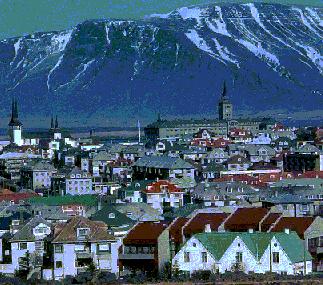 Like
all Northern Germanic tongues, it is derived from Old
Norse, the language of the Vikings who came to Iceland from Norway
in the 9th century AD. From 1380 to 1918 Iceland was ruled by Denmark;
despite this, Icelandic remained virtually uninfluenced, its purity of
form assured by geographic isolation and a strong literary tradition. Even
today Icelandic differs little from Old Norse, and modern readers can easily
read the medieval Eddas and sagas.
Like
all Northern Germanic tongues, it is derived from Old
Norse, the language of the Vikings who came to Iceland from Norway
in the 9th century AD. From 1380 to 1918 Iceland was ruled by Denmark;
despite this, Icelandic remained virtually uninfluenced, its purity of
form assured by geographic isolation and a strong literary tradition. Even
today Icelandic differs little from Old Norse, and modern readers can easily
read the medieval Eddas and sagas.
The Roman alphabet was introduced with Christianity about the year 1000, but the older ð (eth, or voiced th) and þ (thorn, or unvoiced th) were retained, as were æ and ö. The vowels may also take acute accents: á, é, í, ó, ú, and ý.
The Icelandic phonetics contains some interesting features, also sometimes seen in Faroese, like the so-called preaspiration: the process under which the word nytt will be read as [nuht]. Modern Icelandic, which is considered to date from 1540, when the New Testament was translated, is still heavily inflected, unlike the other Scandinavian languages. Icelandic has three genders and four cases of nouns, pronouns, and adjectives; verbs have three persons. The language is equally purist in vocabulary. Linguistic policy formulated in the 18th century generally prevents assimilation of foreign words, so that instead of international scientific and technological terms being adopted, for example, compounds of native Icelandic words are formed; in addition, old words are revived and new ones are created, based on native roots.